Peruvian North Coast Climate Variability and Regional Ocean–Atmosphere Forcing
Abstract
:1. Introduction
2. Data and Methods
3. Results
3.1. North Coast Climate and Seasonality
3.2. Regional Teleconnections
3.3. Dry Climate and Weather
3.4. Shelf Composites: Dry vs. Wet
3.5. Wet Composite
3.6. Diurnal Cycling
3.7. Late Summer Wet Spell, 2023
3.8. Long-Lead Forecasts of Monthly and Daily Rainfall
4. Concluding Discussion
Author Contributions
Funding
Institutional Review Board Statement
Informed Consent Statement
Data Availability Statement
Conflicts of Interest
Appendix A

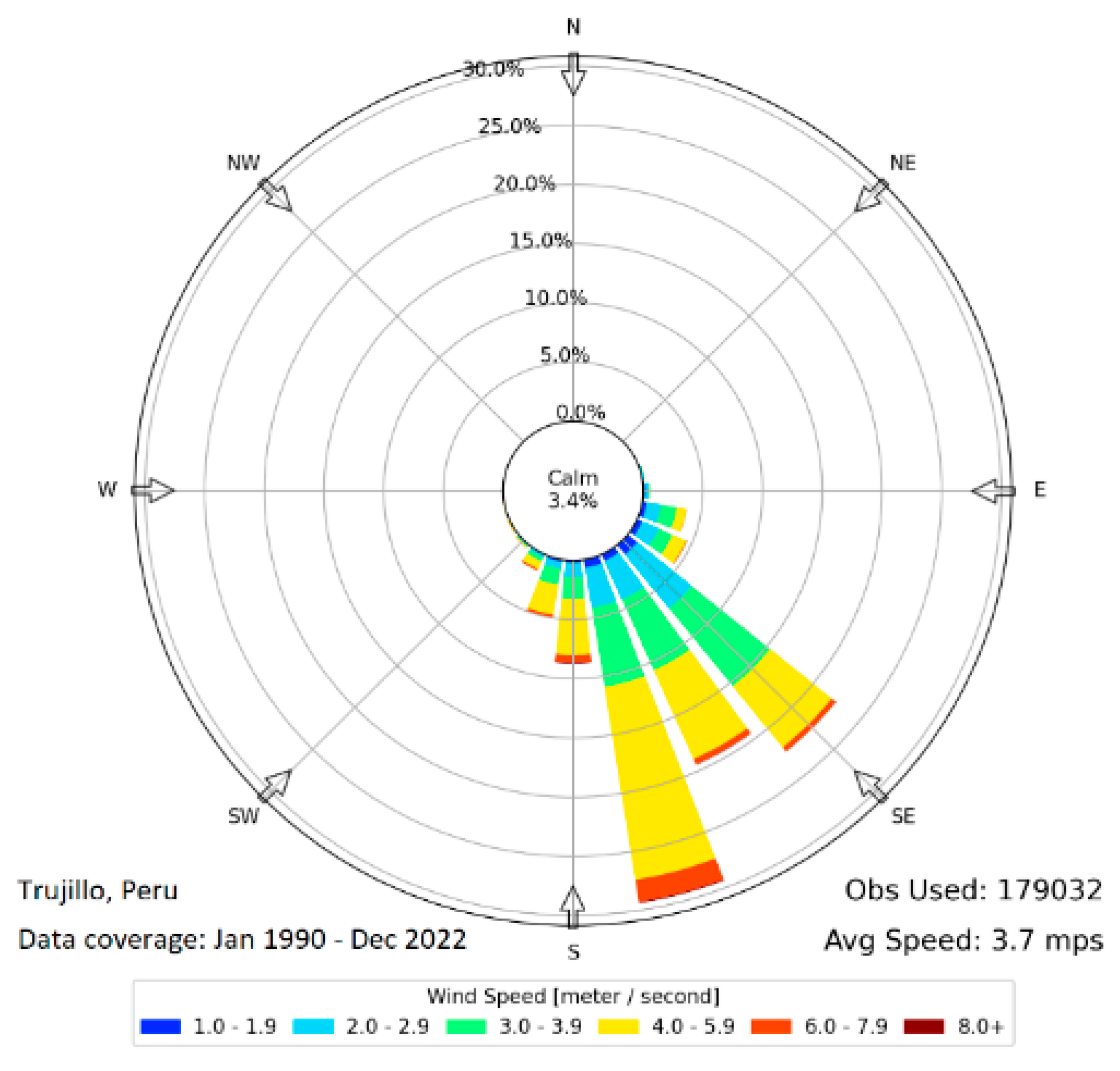
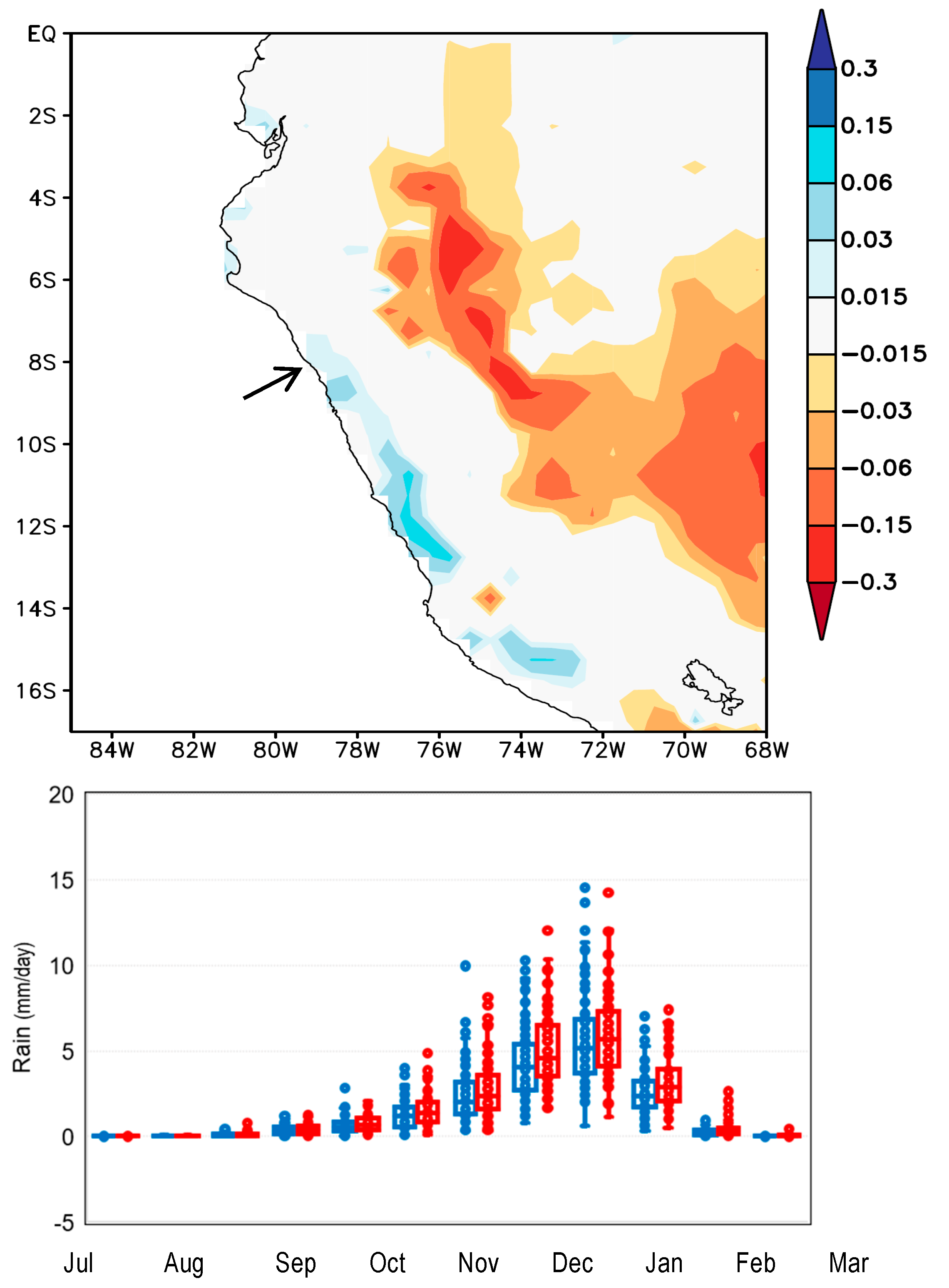
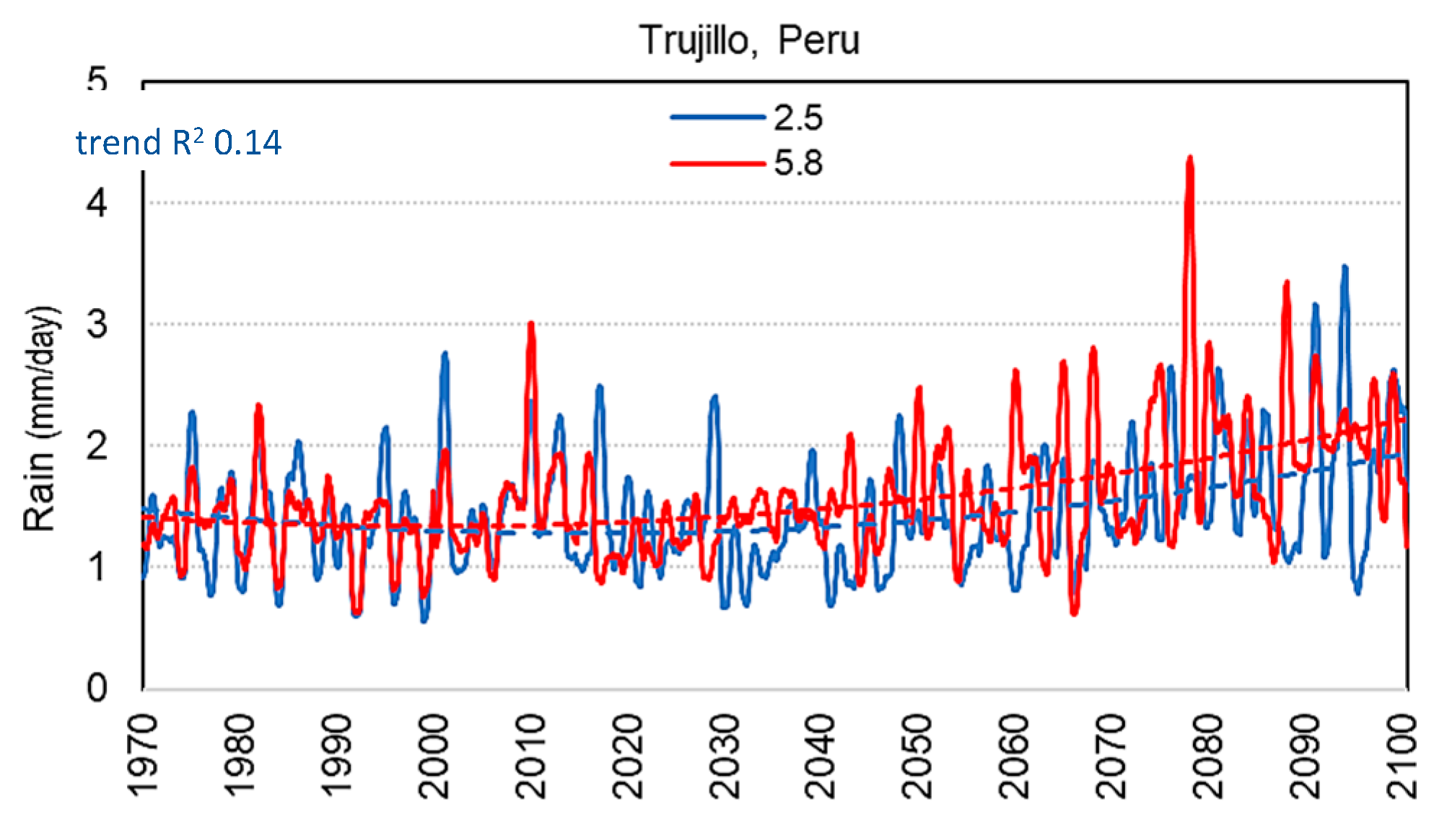
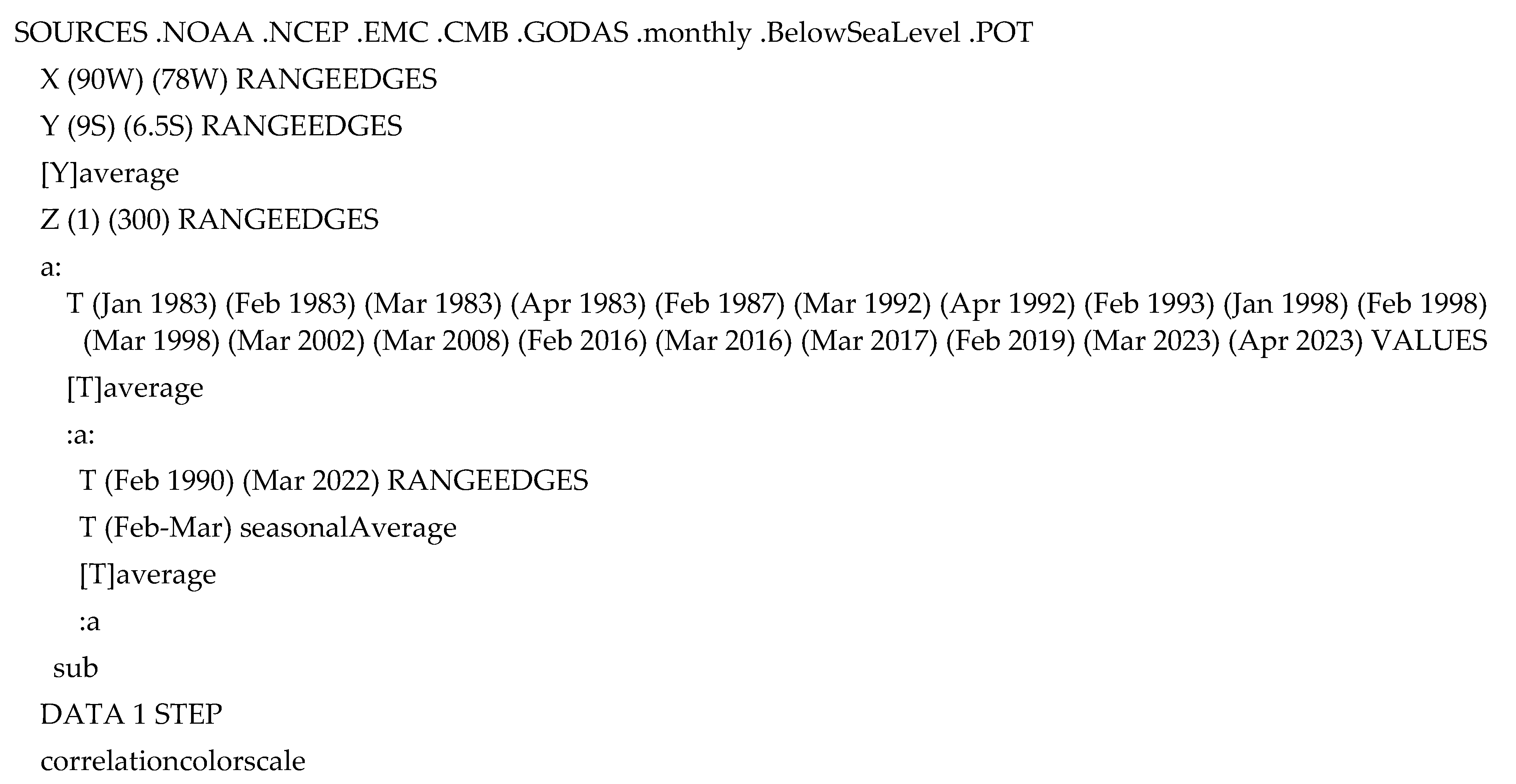
References
- Penven, P.; Echevin, V.; Pasapera, J.; Colas, F.; Tam, J. Average circulation, seasonal cycle, and mesoscale dynamics of the Peru Current System: A modeling approach. J. Geophys. Res. Ocean. 2005, 110, 10021. [Google Scholar] [CrossRef]
- Chamorro-Gomez, A.; Colas, F.; Echevin, V.; Tam, J. Characterization of coastal jets over the Peruvian sea using the WRF regional model. Bol. Inst. Mar. Peru 2022, 37, 271–284. [Google Scholar]
- Briceño-Zuluaga, F.; Flores-Aqueveque, V.; Nogueira, J.; Castillo, A.; Cardich, J.; Rutllant, J.; Caquineau, S.; Sifeddine, A.; Salvatteci, R.; Valdes, J.; et al. Surface wind strength and sea surface temperature connections along the south peruvian coast during the last 150 years. Aeolian Res. 2023, 61, 100855. [Google Scholar] [CrossRef]
- Dewitte, B.; Vazquez-Cuervo, J.; Goubanova, K.; Illig, S.; Takahashi, K.; Cambon, G.; Purca, S.; Correa, D.; Gutierrez, D.; Sifeddine, A.; et al. Change in El Niño flavours over 1958–2008: Implications for the long-term trend of the upwelling off Peru. Deep. Sea Res. Part II Top. Stud. Oceanogr. 2012, 77, 143–156. [Google Scholar] [CrossRef]
- Quispe-Ccalluari, C.; Tam, J.; Demarcq, H.; Chamorro, A.; Espinoza-Morriberón, D.; Romero, C.; Dominguez, N.; Ramos, J.; Oliveros-Ramos, R. An index of coastal thermal effects of El Niño Southern Oscillation on the Peruvian Upwelling Ecosystem. Int. J. Clim. 2018, 38, 3191–3201. [Google Scholar] [CrossRef]
- Philander, S.G. El Niño, La Niña, and the Southern Oscillation; Academic Press: Cambridge, UK, 1990; p. 293. [Google Scholar]
- Lenters, J.D.; Cook, K.H. Summertime precipitation variability over South America: Role of the large-scale circulation. Mon. Weather. Rev. 1999, 127, 409–431. [Google Scholar] [CrossRef]
- Kao, H.; Yu, J. Contrasting eastern- and central-Pacific types of ENSO. J. Clim. 2009, 22, 615–632. [Google Scholar] [CrossRef]
- Hu, X.; Yang, S.; Cai, M. Contrasting the eastern- and central- Pacific El Niño: Process-based feedback attribution. Clim. Dyn. 2016, 47, 2413–2424. [Google Scholar] [CrossRef]
- Alizadeh-Choobari, O. Contrasting global teleconnection features of the eastern Pacific and central Pacific El Niño events. Dyn. Atmos. Ocean. 2017, 80, 139–154. [Google Scholar] [CrossRef]
- Mantua, N.J.; Hare, S.R. The Pacific Decadal Oscillation. J. Oceanogr. 2002, 59, 35–44. [Google Scholar] [CrossRef]
- Cai, W.; McPhaden, M.J.; Grimm, A.M.; Rodrigues, R.R.; Taschetto, A.S.; Garreaud, R.D.; Dewitte, B.; Poveda, G.; Ham, Y.-G.; Santoso, A.; et al. Climate impacts of the El Niño–Southern Oscillation on South America, Nature Rev. Earth Environ. 2020, 1, 215–231. [Google Scholar]
- Sulca, J.; Takahashi, K.; Espinoza, J.-C.; Vuille, M.; Lavado-Casimiro, W. Impacts of different ENSO flavors and tropical Pacific convection variability (ITCZ, SPCZ) on austral summer rainfall in South America, with a focus on Peru. Int. J. Clim. 2018, 38, 420–435. [Google Scholar] [CrossRef]
- Gonzales, E.; Ingol, E. Determination of a new coastal ENSO oceanic index for northern Peru. Climate 2021, 9, 71. [Google Scholar] [CrossRef]
- Caramanica, A.; Mesia, L.H.; Morales, C.R.; Huckleberry, G.; Castillo, B.L.J.; Quilter, J. El Niño resilience farming on the north coast of Peru. Proc. Nat. Acad. Sci. USA 2020, 117, 24127–24137. [Google Scholar] [CrossRef] [PubMed]
- White, W.B. Tropical coupled Rossby waves in the Pacific ocean–atmosphere system. J. Phys. Oceanogr. 2020, 30, 1245–1264. [Google Scholar] [CrossRef]
- Rydbeck, A.V.; Jensen, T.G.; Flatau, M. Characterization of intra-seasonal Kelvin waves in the equatorial Pacific Ocean. J. Geophys. Res. Ocean. 2019, 124, 2028–2053. [Google Scholar] [CrossRef]
- Bourrel, L.; Rau, P.; Dewitte, B.; Labat, D.; Lavado, W.; Coutaud, A.; Vera, A.; Alvarado, A.; Ordoñez, J. Low-frequency modulation and trend of the relationship between ENSO and precipitation along the northern to centre Peruvian Pacific coast. Hydrol. Process. 2015, 29, 1252–1266. [Google Scholar] [CrossRef]
- Sanabria, J.; Bourrel, L.; Dewitte, B.; Frappart, F.; Rau, P.; Solis, O.; Labat, D. Rainfall along the coast of Peru during strong El Niño events. Intl. J. Climatol. 2018, 38, 1737–1747. [Google Scholar] [CrossRef]
- Douglas, M.W.; Mejia, J.; Ordinola, N.; Boustead, J. Synoptic variability of rainfall and cloudiness along the coast of northern Peru and Ecuador during the 1997/98 El Niño Event. Mon. Wea. Rev. 2009, 137, 116–136. [Google Scholar] [CrossRef]
- Rodríguez-Morata, C.; Díaz, H.F.; Ballesteros-Canovas, J.A.; Rohrer, M.; Stoffel, M. The anomalous 2017 coastal El Niño event in Peru. Clim. Dyn. 2019, 52, 5605–5622. [Google Scholar] [CrossRef]
- Recalde-Coronel, G.C.; Zaitchik, B.; Pan, W.K. Madden–Julian oscillation influence on sub-seasonal rainfall variability on the west of South America. Clim. Dyn. 2020, 54, 2167–2185. [Google Scholar] [CrossRef] [PubMed]
- Rosales, A.G.; Junquas, C.; da Rocha, R.P.; Condom, T.; Espinoza, J.-C. Valley–mountain circulation associated with the diurnal cycle of precipitation in the tropical andes (Santa River Basin, Peru). Atmosphere 2022, 13, 344. [Google Scholar] [CrossRef]
- Maes, W.H.; Gentine, P.; Verhoest, N.E.C.; Miralles, D.G. Potential evaporation at eddy-covariance sites across the globe. Hydrol. Earth Syst. Sci. 2018, 23, 925–948. [Google Scholar] [CrossRef]
- McMahon, T.A.; Peel, M.C.; Lowe, L.; Srikanthan, R.; McVicar, T.R. Estimating actual, potential, reference crop and pan evaporation using standard meteorological data: A pragmatic synthesis. Hydrol. Earth Syst. Sci. 2013, 17, 1331–1363. [Google Scholar] [CrossRef]
- Saha, S.; Moorthi, S.; Wu, X.; Wang, J.; Nadiga, S.; Tripp, P.; Behringer, D.; Hou, Y.-T.; Chuang, H.-Y.; Iredell, M.; et al. The NCEP climate forecast system version 2. J. Clim. 2014, 27, 2185–2208. [Google Scholar] [CrossRef]
- Johnson, S.J.; Stockdale, T.N.; Ferranti, L.; Balmaseda, M.A.; Molteni, F.; Magnusson, L.; Tietsche, S.; Decremer, D.; Weisheimer, A.; Balsamo, G.; et al. SEAS5: The new ECMWF seasonal forecast system. Geosci. Model Dev. 2019, 12, 1087–1117. [Google Scholar] [CrossRef]
- Harrigan, S.; Zsoter, E.; Alfieri, L.; Prudhomme, C.; Salamon, P.; Wetterhall, F.; Barnard, C.; Cloke, H.; Pappenberger, F. GloFAS-ERA5 operational global river discharge reanalysis 1979–present, Earth Syst. Sci. Data 2020, 12, 2043–2060. [Google Scholar]
- Faugère, Y.; Taburet, G.; Ballarotta, M.; Pujol, I.; Legeais, J.F.; Maillard, G.; Chloe, D.; Quentin, D.; Marine, L.; Antonio, S.R.; et al. DUACS-dt21: 28 years of reprocessed sea level altimetry products. In Proceedings of the Assembly Proceedings EGU22-7479, Vienna, Austria, 23–27 May 2022. [Google Scholar]
- Hersbach, H.; Bell, B.; Berrisford, P.; Hirahara, S.; Horányi, A.; Muñoz-Sabater, J.; Nicolas, J.; Peubey, C.; Radu, R.; Schepers, D.; et al. The ERA5 global reanalysis. Qtr. J. R. Meteo. Soc. 2020, 146, 1999–2049. [Google Scholar] [CrossRef]
- Behringer, D.W. The global ocean data assimilation system (GODAS) at NCEP. In Proceedings of the 11th Symposium on Integrated Observing and Assimilation Systems for the Atmosphere, Oceans, and Land Surface, San Antonio, TX, USA, 14–18 January 2007. [Google Scholar]
- Hou, A.Y.; Kakar, R.K.; Neeck, S.; Azarbarzin, A.A.; Kummerow, C.D.; Kojima, M.; Oki, R.; Nakamura, K.; Iguchi, T. The Global Precipitation Measurement mission. Bull. Am. Meteorol. Soc. 2014, 95, 701–722. [Google Scholar] [CrossRef]
- Ghiggi, G.; Humphrey, V.; Seneviratne, S.I.; Gudmundsson, L. G-RUN ENSEMBLE: A multi-forcing observation-based global runoff reanalysis. Water Resour. Res. 2021, 57, e2020WR028787. [Google Scholar] [CrossRef]
- Rayner, N.A.; Parker, D.E.; Horton, E.B.; Horton, E.B.; Folland, C.K.; Alexander, L.V.; Rowell, D.P.; Kent, E.C.; Kaplan, A. Global analyses of sea surface temperature, sea ice, and night marine air temperature since the late nineteenth century. J. Geophys. Res. 2003, 108, 4407. [Google Scholar] [CrossRef]
- Gelaro, R.; McCarty, W.; Suárez, M.J.; Todling, R.; Molod, A.; Takacs, L.; Randles, C.A.; Darmenov, A.; Bosilovich, M.G.; Reichle, R.; et al. The modern-era retrospective analysis for research and applications, v2 (MERRA2). J. Clim. 2017, 30, 5419–5454. [Google Scholar] [CrossRef] [PubMed]
- Pinzon, J.E.; Tucker, C.J. A non-stationary AVHRR NDVI time series. Remote Sens. 2014, 6, 6929–6960. [Google Scholar] [CrossRef]
- Zhang, T.; Hoell, A.; Perlwitz, J.; Eischeid, J.; Murray, D.; Hoerling, M.; Hamill, T.M. Towards probabilistic multi-variate ENSO monitoring. Geophys. Res. Lett. 2019, 46, 10532–10540. [Google Scholar] [CrossRef]
- Lee, H.-T.; Gruber, A.; Ellingson, R.G.; Laszlo, I. Development of the HIRS outgoing longwave radiation climate dataset. J. Atmos. Ocean. Technol. 2007, 24, 2029–2047. [Google Scholar] [CrossRef]
- Echevin, V.; Colas, F.; Espinoza-Morriberon, D.; Vasquez, L.; Anculle, T.; Gutierrez, D. Forcing and evolution of the 2017 coastal El Niño off northern Peru and Ecuador, Frontiers Mar. Science 2018, 5, 3389. [Google Scholar]
- Grados, C.; Chaigneau, A.; Echevin, V.; Dominguez, N. Upper ocean hydrology of the northern Humboldt Current system at seasonal, interannual and interdecadal scales. Prog. Oceanogr. 2018, 165, 123–144. [Google Scholar] [CrossRef]
- Roundy, P.E.; Kiladis, G.N. Observed relationships between oceanic kelvin waves and atmospheric forcing. J. Clim. 2006, 19, 5253–5272. [Google Scholar] [CrossRef]
- Jury, M.R. Global wave-2 structure of ENSO-modulated convection. Int. J. Clim. 2019, 39, 2438–2448. [Google Scholar] [CrossRef]
- Wei, Y.; Ren, H.-L. Modulation of ENSO on fast and slow MJO modes during boreal winter. J. Clim. 2019, 32, 7483–7506. [Google Scholar] [CrossRef]
- French, A.; Mechler, R.; Arestegui, M.; MacClune, K.; Cisneros, A. Root causes of recurrent catastrophe: The political ecology of El Nino-related disasters in Peru. Int. J. Disaster Risk Reduct. 2020, 47, 101539. [Google Scholar] [CrossRef]
 ) and
gauges on the western slope (Δ), (D)
near-surface wind field (vector, largest 8 m/s) and ocean mixed layer depth
(red contours, m), (E) wind speed on 8S slice. Long-term SST analysis: (F)
average, (G) variance, (H) annual cycle in Moche area Peru (red
mean, green upper/lower quintiles), based on daily data 1979–2022.
) and
gauges on the western slope (Δ), (D)
near-surface wind field (vector, largest 8 m/s) and ocean mixed layer depth
(red contours, m), (E) wind speed on 8S slice. Long-term SST analysis: (F)
average, (G) variance, (H) annual cycle in Moche area Peru (red
mean, green upper/lower quintiles), based on daily data 1979–2022.
 ) and
gauges on the western slope (Δ), (D)
near-surface wind field (vector, largest 8 m/s) and ocean mixed layer depth
(red contours, m), (E) wind speed on 8S slice. Long-term SST analysis: (F)
average, (G) variance, (H) annual cycle in Moche area Peru (red
mean, green upper/lower quintiles), based on daily data 1979–2022.
) and
gauges on the western slope (Δ), (D)
near-surface wind field (vector, largest 8 m/s) and ocean mixed layer depth
(red contours, m), (E) wind speed on 8S slice. Long-term SST analysis: (F)
average, (G) variance, (H) annual cycle in Moche area Peru (red
mean, green upper/lower quintiles), based on daily data 1979–2022.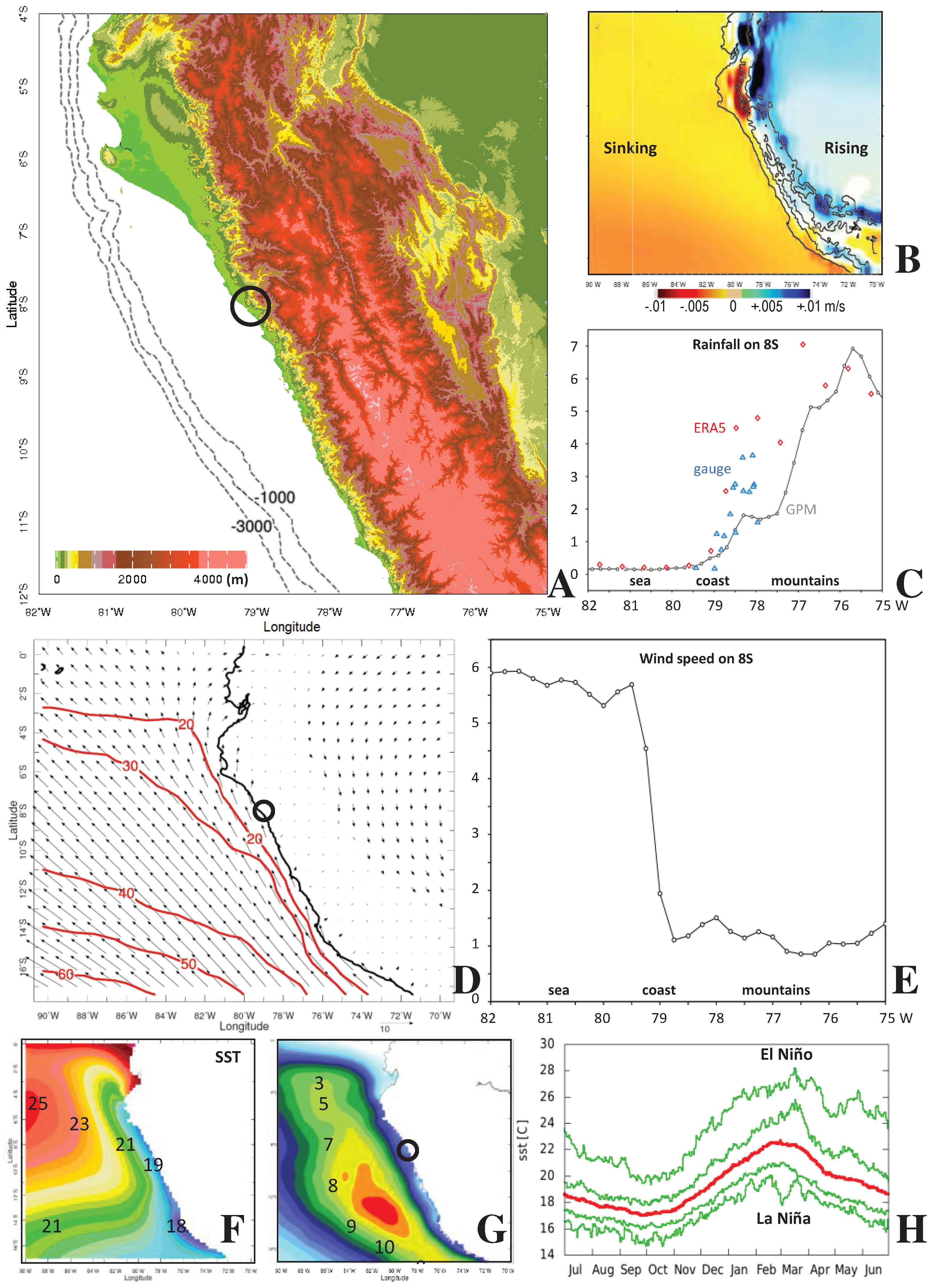
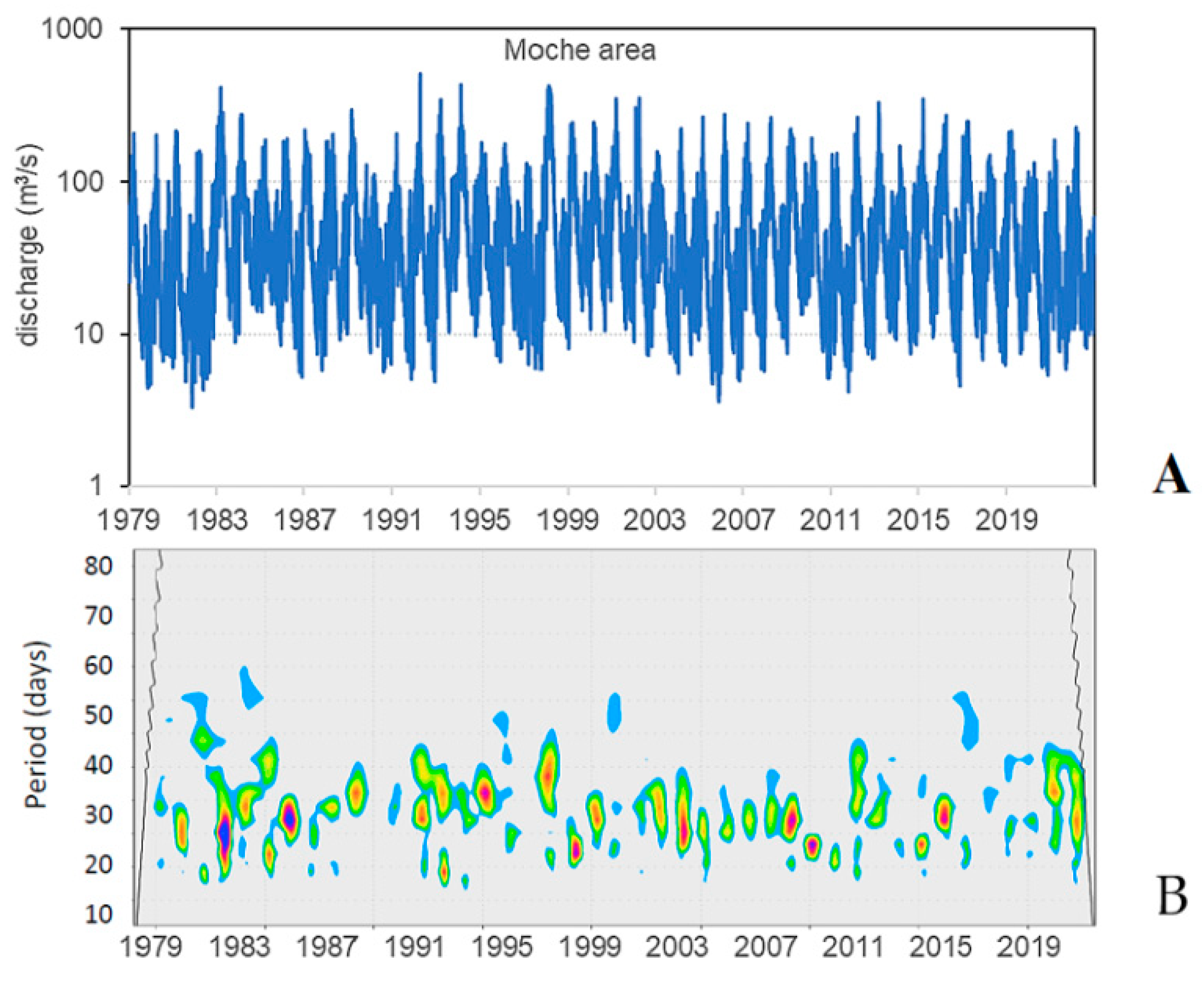
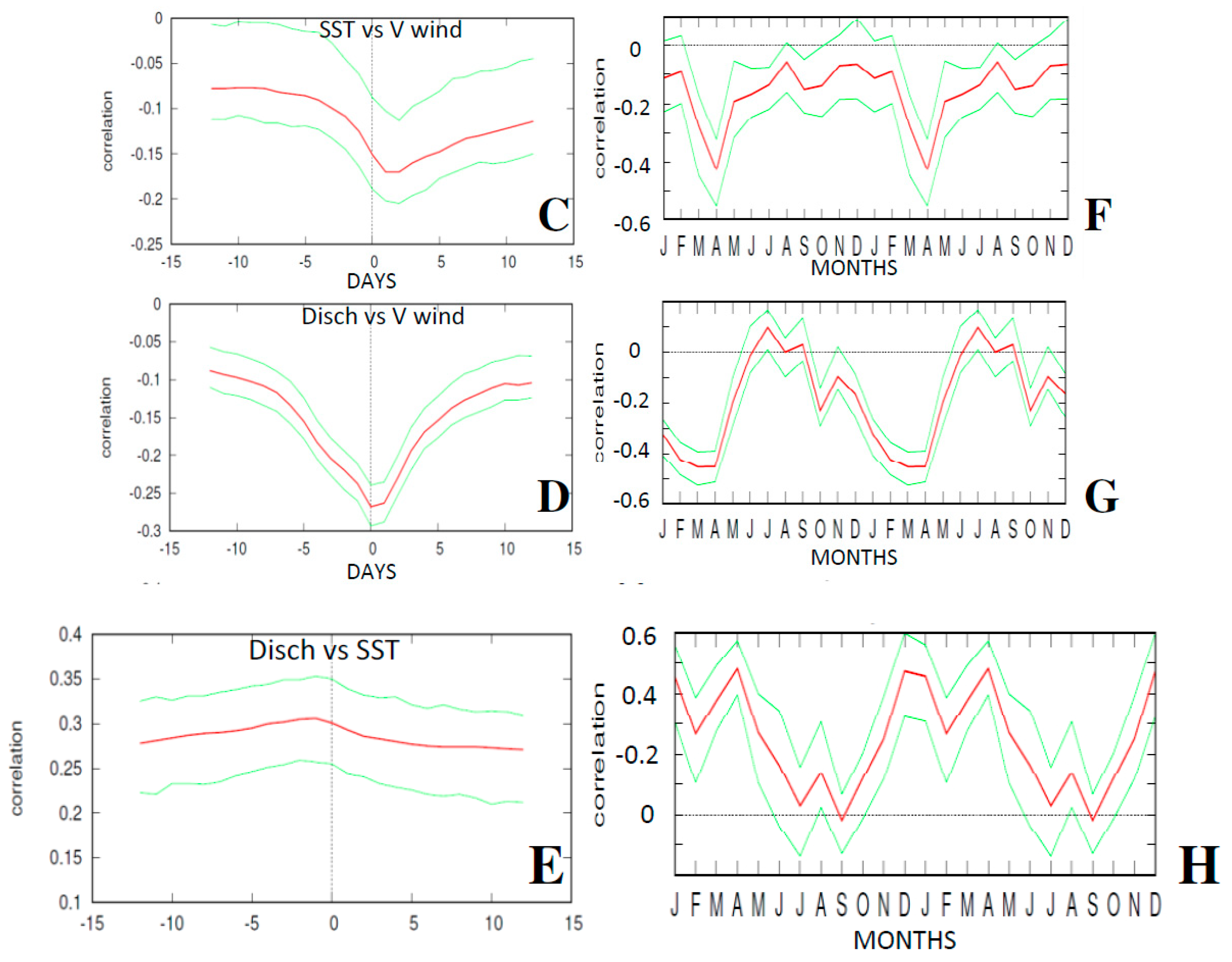
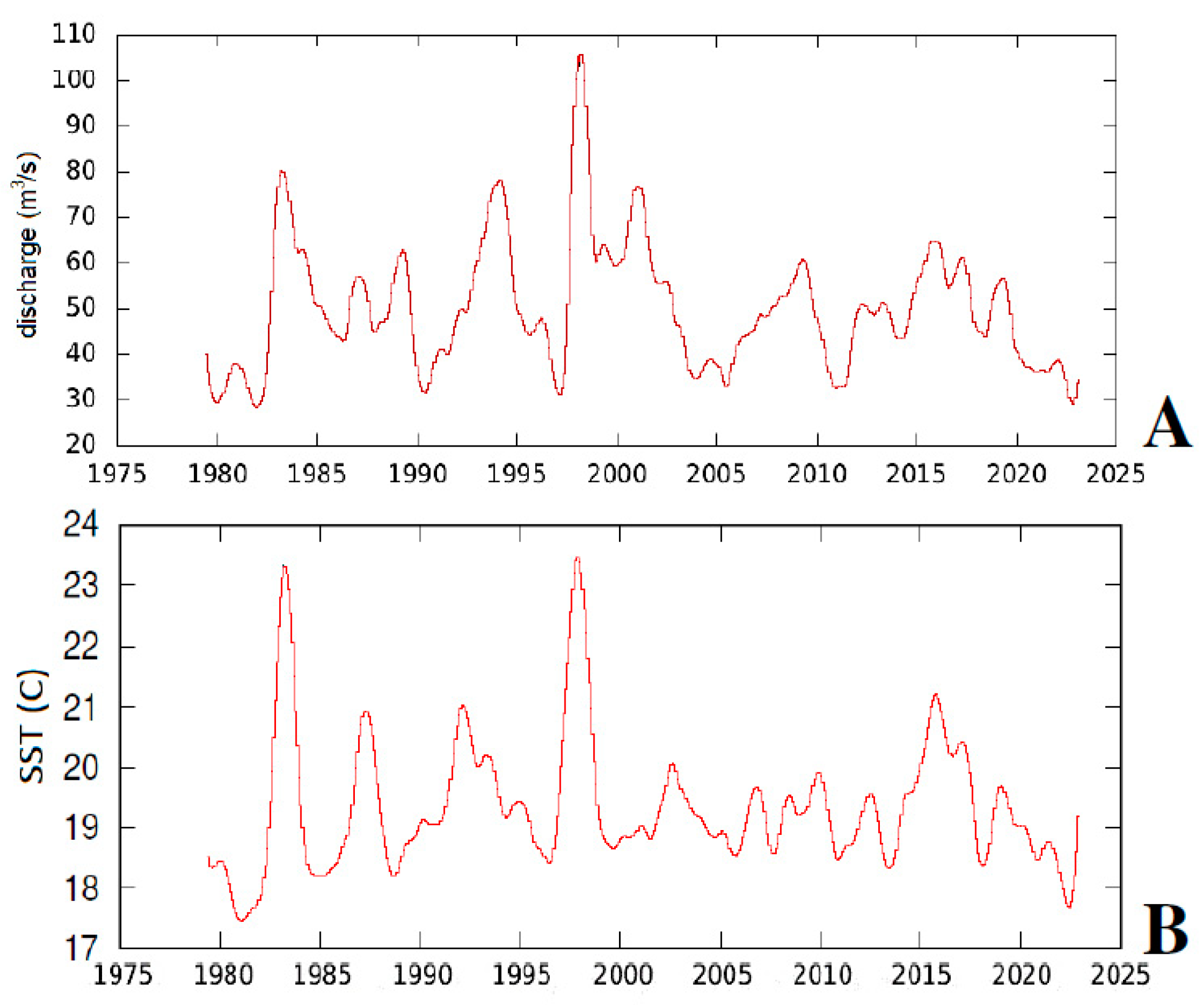
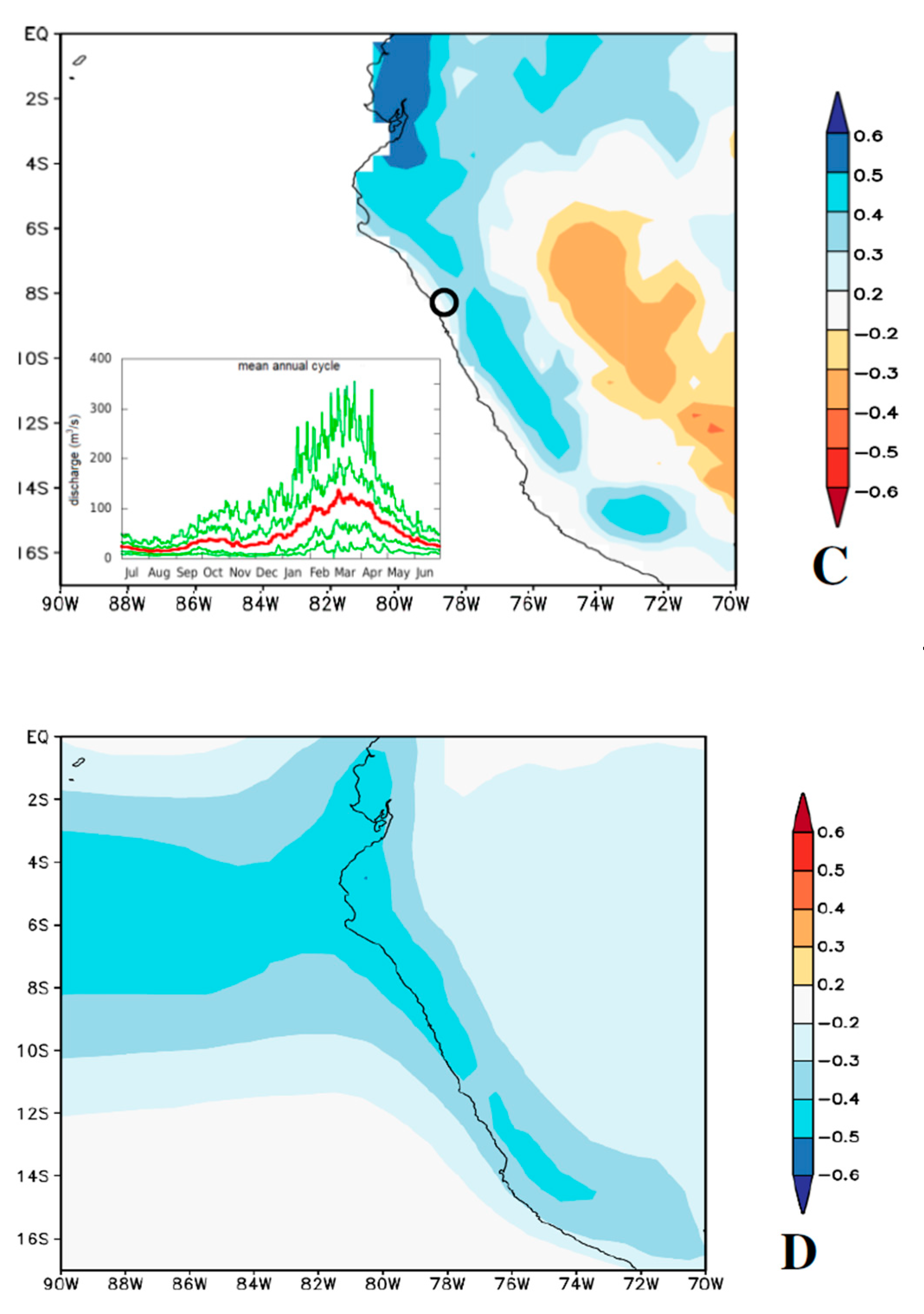
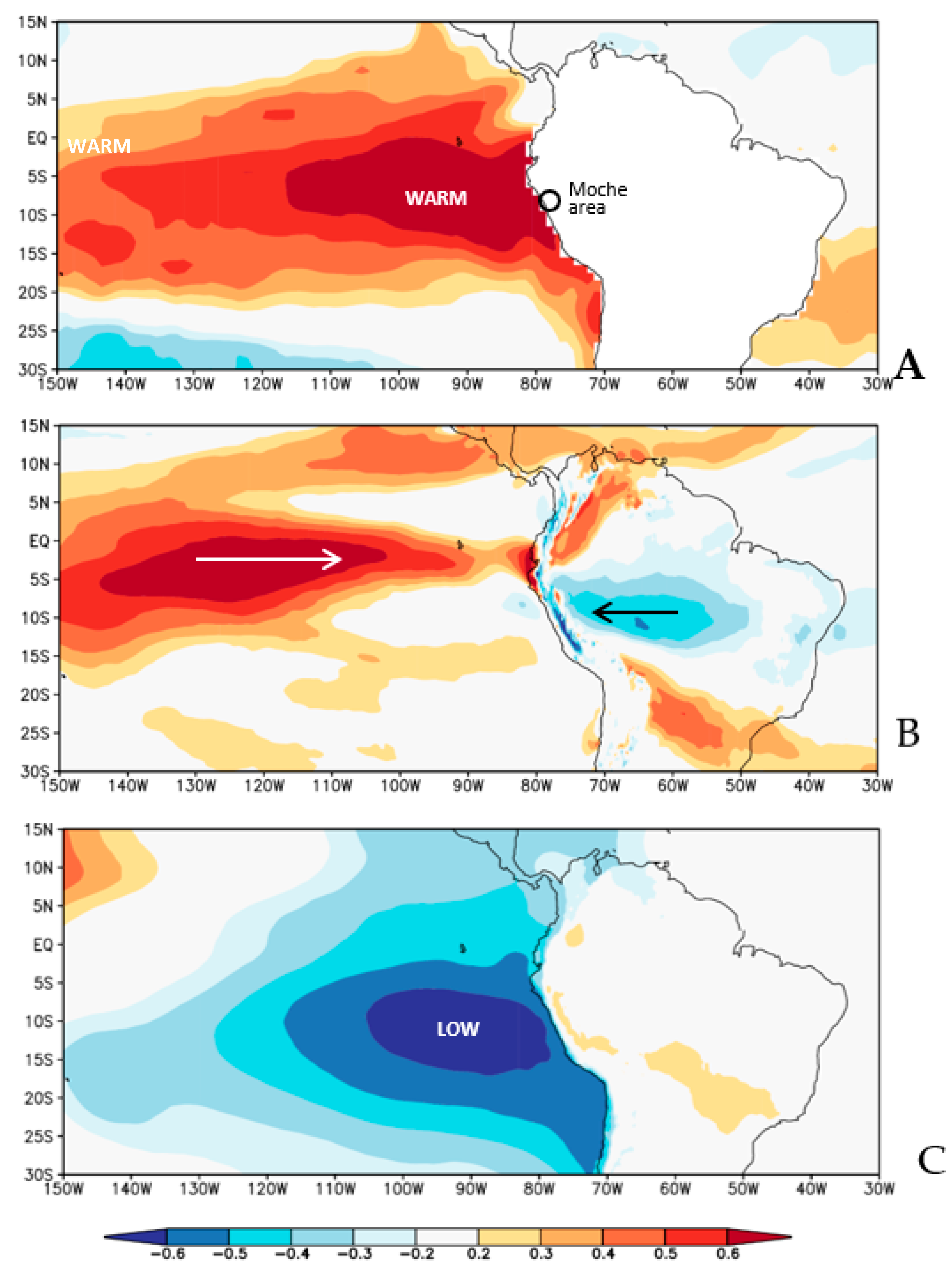
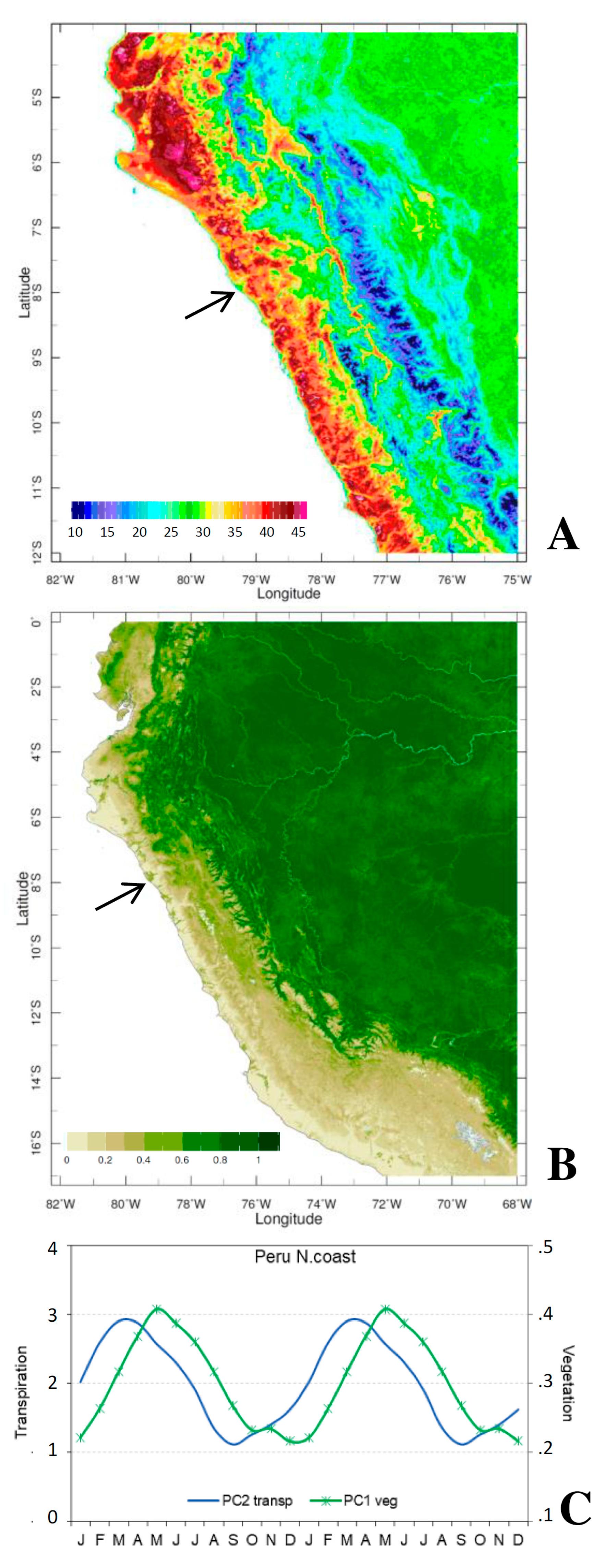

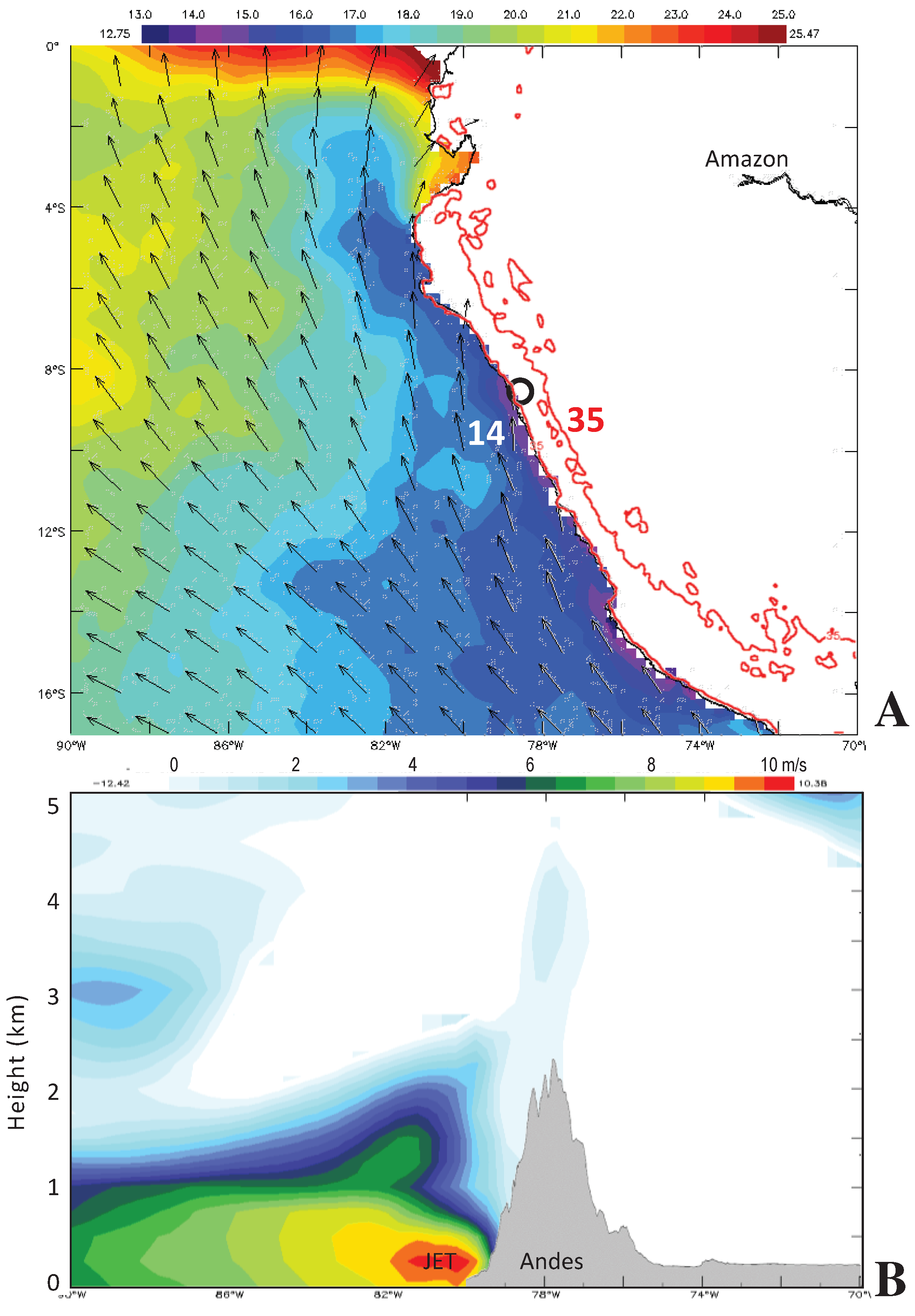

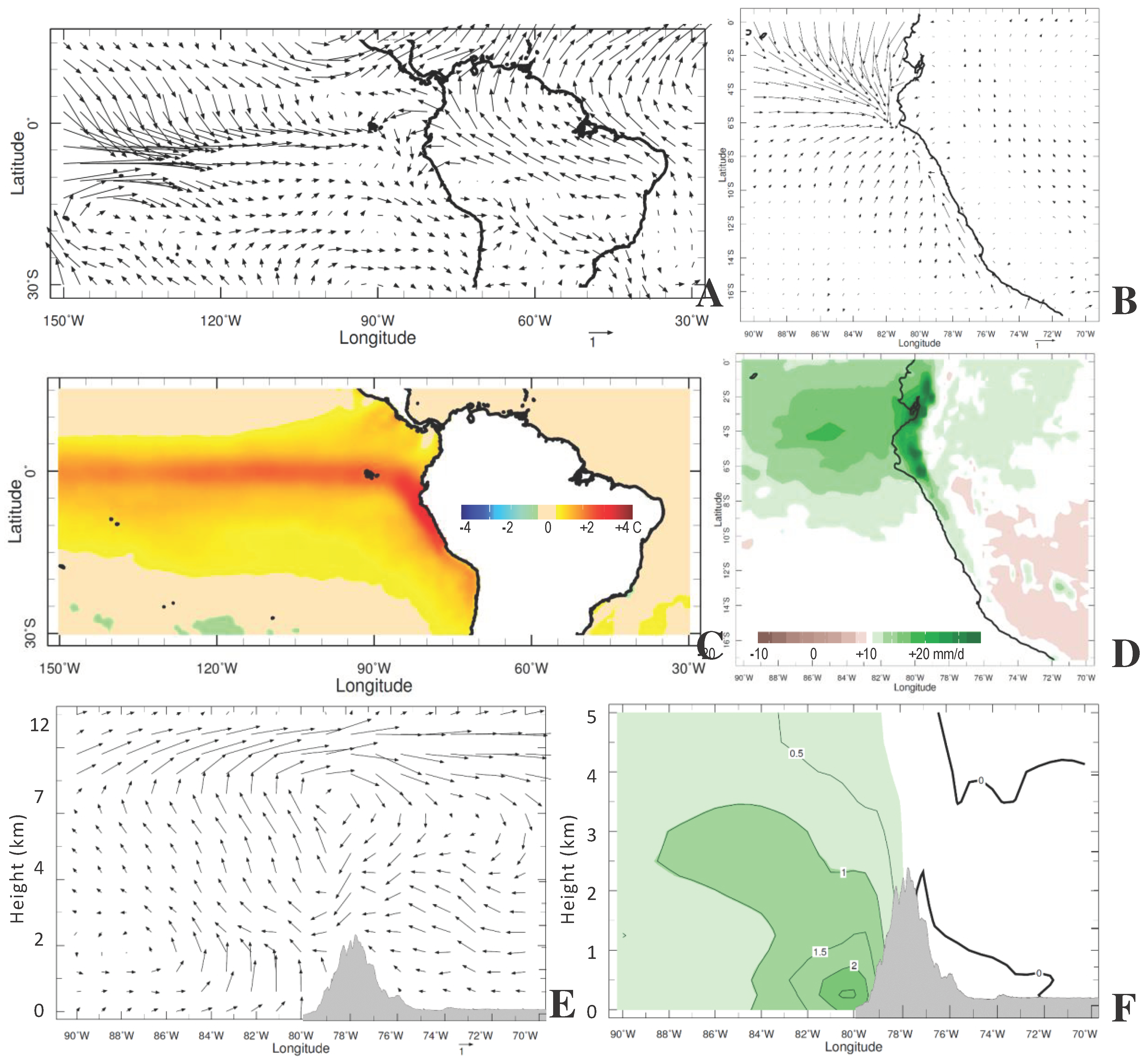
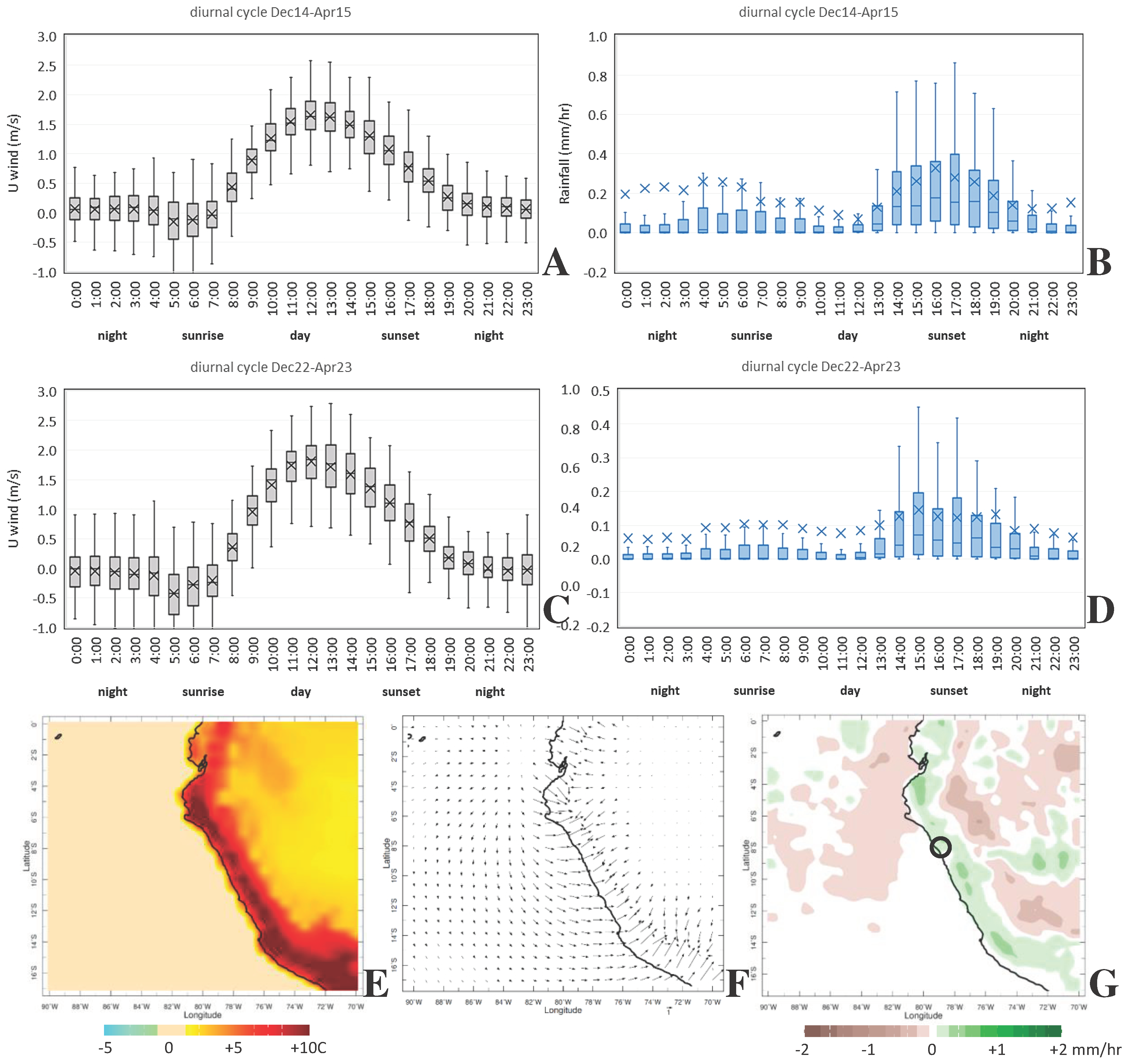
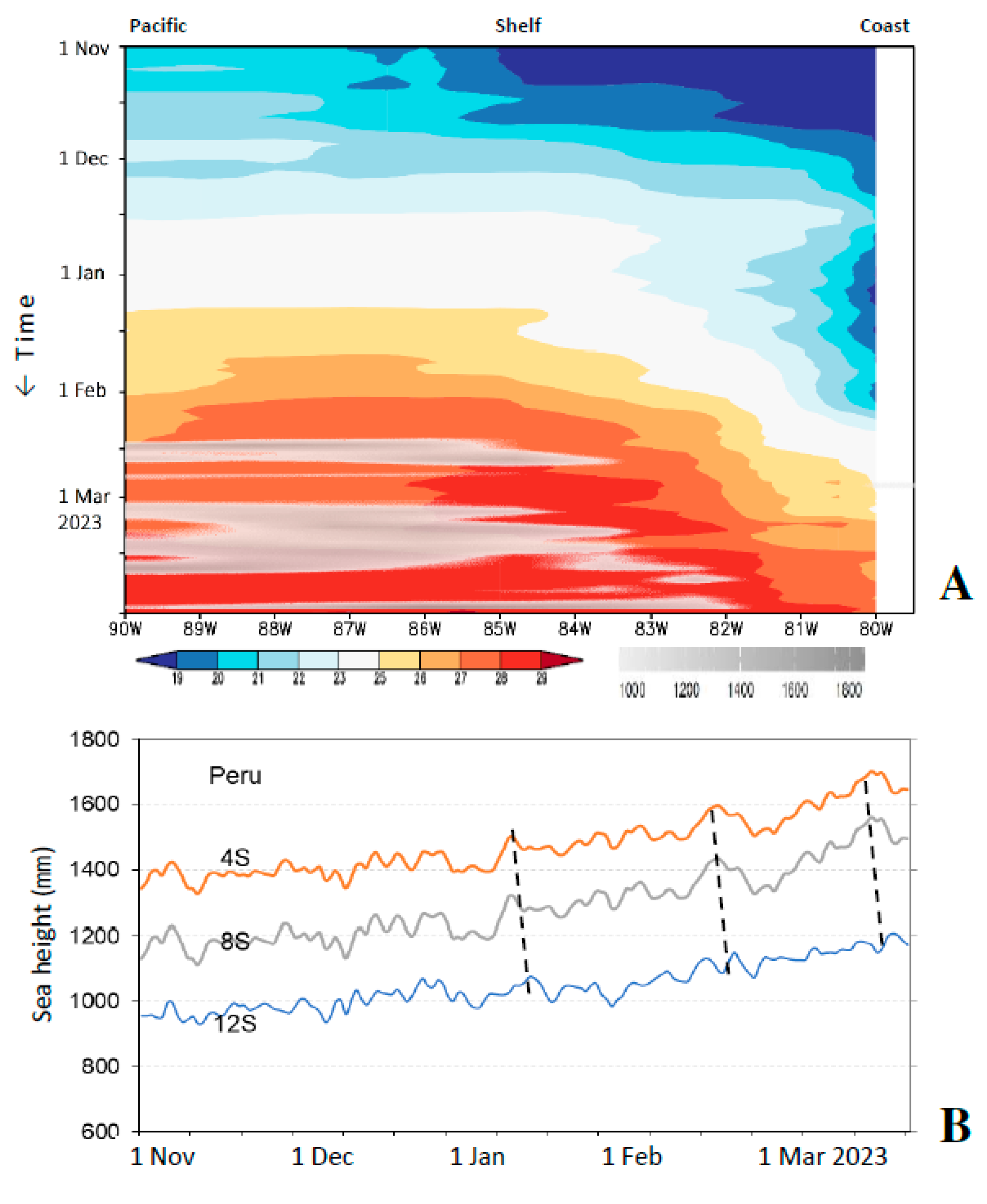

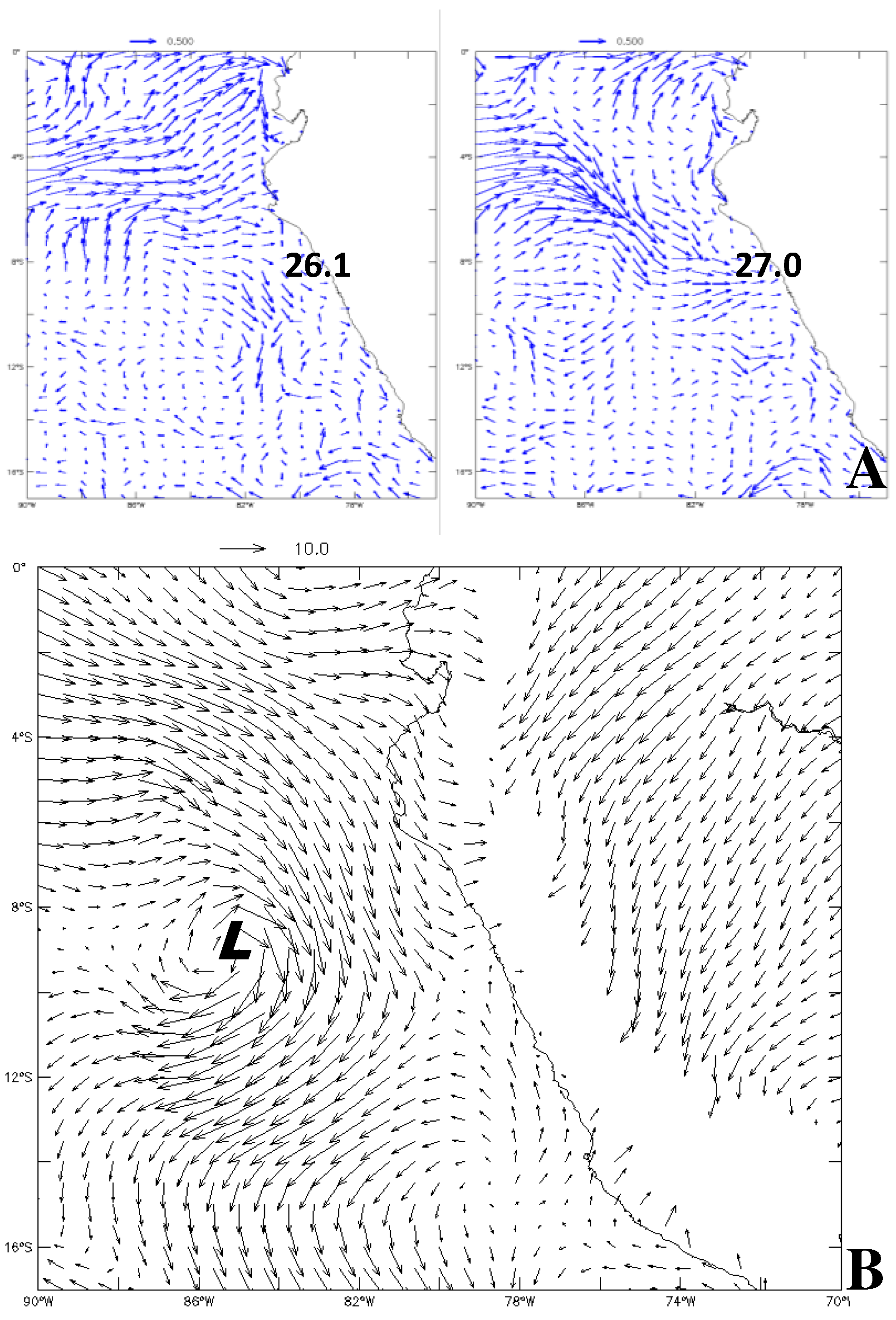
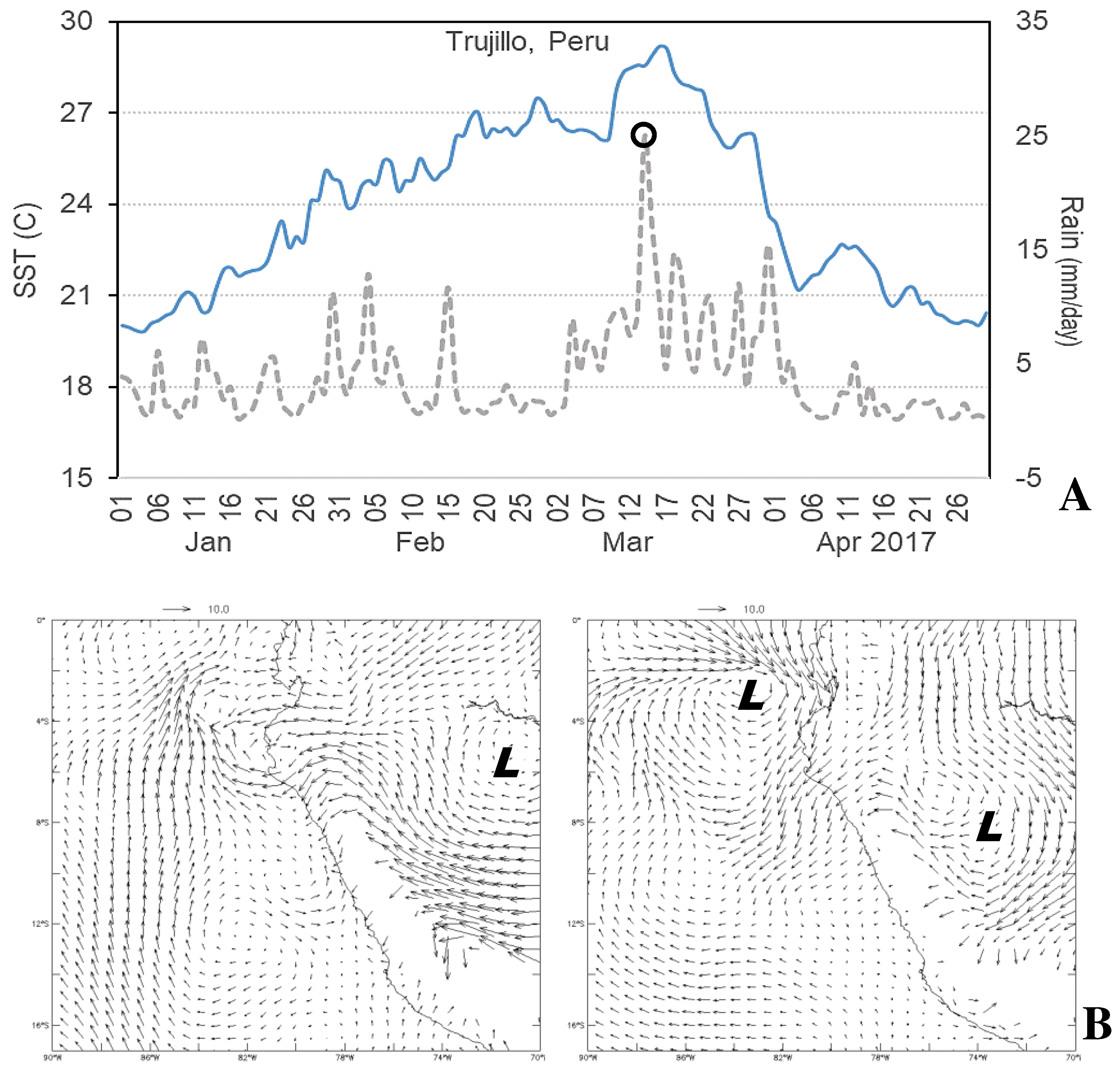
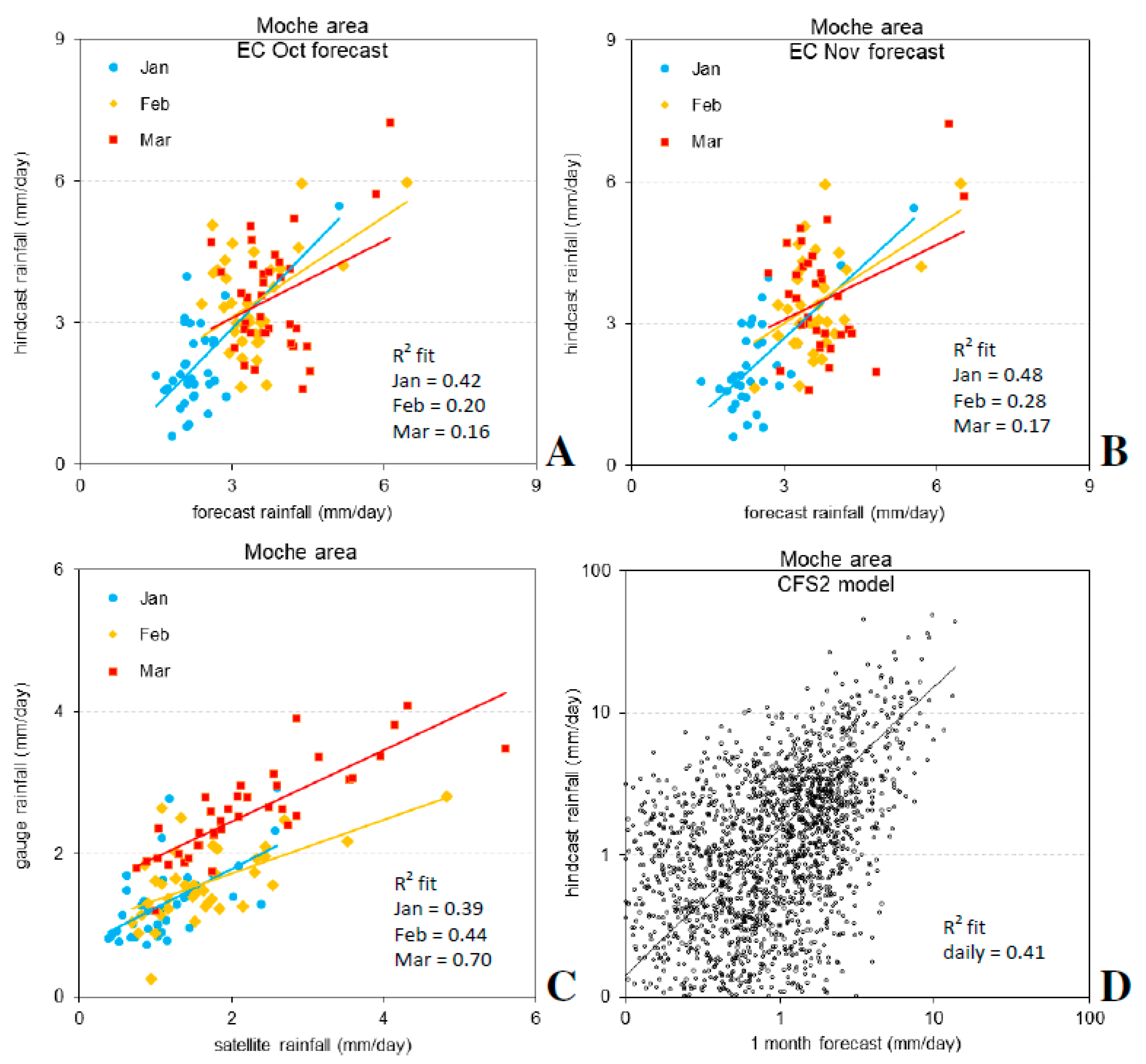
| Acronym | Name (Variables) | Horz.Res. | Reference Document |
|---|---|---|---|
| CFS2 | Coupled Forecast System v2 reanalysis and ensemble model (rainfall, wind) | 25 km | [26] |
| EC-model | ECMWF coupled ensemble model v5 (monthly rain forecasts) | 100 km | [27] |
| EC-river | European Community Glofas reanalysis (river discharge) | 20 km | [28] |
| EC-ssh 1993+ | European Copernicus (multi-satellite altimeter + gauge sea surface height) | 25 km | [29] |
| ERA5 | European Reanalysis v5 (air press., temp., wind, vertical motion, humidity, pot. evap., CAPE) | 25 km | [30] |
| GODAS | Global Ocean Data Assimilation System NOAA (currents, vertical motion, sea temperature, salinity) | 50 km | [31] |
| GPM 2000+ | Global Precipitation Monitoring (multi-satellite + gauge rainfall) | 20 km | [32] |
| GRUN | Global Runoff v2 (surface hydrology) | 50 km | [33] |
| HADLEY | Hadley Centre reanalysis (sea surface temperature) | 100 km | [34] |
| HYCOM3 2000+ | Hybrid coupled ocean model reanalysis v3 (currents) | 10 km | [35] |
| In situ | Weather station data from Trujillo Peru Tide gauge measurements at 4, 8, 12S | point | IEM wind rose IOC sea level |
| MERRA2 | NASA atmospheric reanalysis v2 (diurnal cycle) | 50 km | [36] |
| NDVI 1981+ | Normalized Difference Vegetation Index (satellite color fraction) | 1 km | [37] |
| NOAA | ENSO variables (Nino1–2, 3, 4 SST, MEI2, PDO) | 25 km | [38] |
| OLR | Satellite net outgoing longwave radiation (moist convection) | 100 km | [39] |
| (a) Dry | |||
| Year, Month | Pot. Evap. | Disch. | SST |
| 1979-10 | 5.55 | 16.9 | 16.0 |
| 1979-11 | 5.86 | 6.2 | 17.1 |
| 1985-11 | 5.69 | 18.6 | 17.6 |
| 1986-10 | 5.58 | 14.8 | 17.5 |
| 1989-11 | 5.90 | 27.4 | 17.7 |
| 1989-12 | 5.67 | 11.6 | 18.9 |
| 1992-11 | 5.56 | 12.7 | 18.3 |
| 1996-11 | 5.57 | 19.8 | 17.4 |
| 1998-11 | 5.87 | 22.3 | 17.9 |
| 2000-11 | 5.62 | 35.6 | 16.8 |
| 2001-12 | 5.57 | 20.7 | 18.1 |
| 2003-10 | 5.60 | 17.8 | 17.3 |
| 2003-11 | 5.69 | 12.6 | 18.9 |
| 2005-11 | 5.69 | 20.2 | 16.6 |
| 2016-10 | 5.60 | 27.2 | 18.4 |
| 2016-11 | 6.03 | 10.7 | 18.6 |
| 2022-10 | 5.70 | 19.6 | 15.5 |
| 2022-11 | 5.75 | 14.0 | 17.3 |
| (b) Wet | |||
| Year, Month | Precip. | Disch. | SST |
| 1983-1 | 4.86 | 123.3 | 25.8 |
| 1983-2 | 6.01 | 121.0 | 26.0 |
| 1983-3 | 8.01 | 185.1 | 26.6 |
| 1983-4 | 5.88 | 176.9 | 26.9 |
| 1987-2 | 5.44 | 139.0 | 24.7 |
| 1992-3 | 4.29 | 107.4 | 25.6 |
| 1992-4 | 4.35 | 125.0 | 24.1 |
| 1993-2 | 6.11 | 115.3 | 23.5 |
| 1998-1 | 6.82 | 173.5 | 26.1 |
| 1998-2 | 7.73 | 231.5 | 26.7 |
| 1998-3 | 9.91 | 295.9 | 26.6 |
| 2002-3 | 4.72 | 155.0 | 24.9 |
| 2008-3 | 5.26 | 136.5 | 24.7 |
| 2016-2 | 4.70 | 115.8 | 24.7 |
| 2016-3 | 4.93 | 143.1 | 23.6 |
| 2017-3 | 7.47 | 173.2 | 27.1 |
| 2019-2 | 4.52 | 124.7 | 23.8 |
| 2023-3 | 7.55 | 25.8 | |
| 2023-4 | 5.93 | 25.1 | |
| Lead/Lag | Nino1 + 2 | Nino3 | MEI 2 | PDO | Nino4 |
|---|---|---|---|---|---|
| −6 | 0.11 | −0.05 | −0.17 | −0.05 | −0.07 |
| −5 | 0.19 | 0.01 | −0.05 | 0.01 | −0.07 |
| −4 | 0.27 | 0.13 | 0.16 | −0.03 | −0.06 |
| −3 | 0.38 | 0.27 | 0.34 | 0.03 | −0.05 |
| −2 | 0.51 | 0.42 | 0.40 | 0.09 | −0.03 |
| −1 | 0.63 | 0.48 | 0.38 | 0.16 | −0.02 |
| 0 | 0.66 | 0.45 | 0.35 | 0.20 | 0.01 |
| +1 | 0.63 | 0.41 | 0.34 | 0.20 | 0.03 |
| +2 | 0.58 | 0.37 | 0.31 | 0.22 | 0.05 |
| +3 | 0.57 | 0.38 | 0.30 | 0.24 | 0.07 |
| +4 | 0.58 | 0.41 | 0.32 | 0.23 | 0.12 |
| +5 | 0.59 | 0.44 | 0.36 | 0.27 | 0.16 |
| +6 | 0.59 | 0.45 | 0.39 | 0.28 | 0.18 |
Disclaimer/Publisher’s Note: The statements, opinions and data contained in all publications are solely those of the individual author(s) and contributor(s) and not of MDPI and/or the editor(s). MDPI and/or the editor(s) disclaim responsibility for any injury to people or property resulting from any ideas, methods, instructions or products referred to in the content. |
© 2024 by the authors. Licensee MDPI, Basel, Switzerland. This article is an open access article distributed under the terms and conditions of the Creative Commons Attribution (CC BY) license (https://creativecommons.org/licenses/by/4.0/).
Share and Cite
Jury, M.R.; Alfaro-Garcia, L.E. Peruvian North Coast Climate Variability and Regional Ocean–Atmosphere Forcing. Coasts 2024, 4, 508-534. https://doi.org/10.3390/coasts4030026
Jury MR, Alfaro-Garcia LE. Peruvian North Coast Climate Variability and Regional Ocean–Atmosphere Forcing. Coasts. 2024; 4(3):508-534. https://doi.org/10.3390/coasts4030026
Chicago/Turabian StyleJury, Mark R., and Luis E. Alfaro-Garcia. 2024. "Peruvian North Coast Climate Variability and Regional Ocean–Atmosphere Forcing" Coasts 4, no. 3: 508-534. https://doi.org/10.3390/coasts4030026





